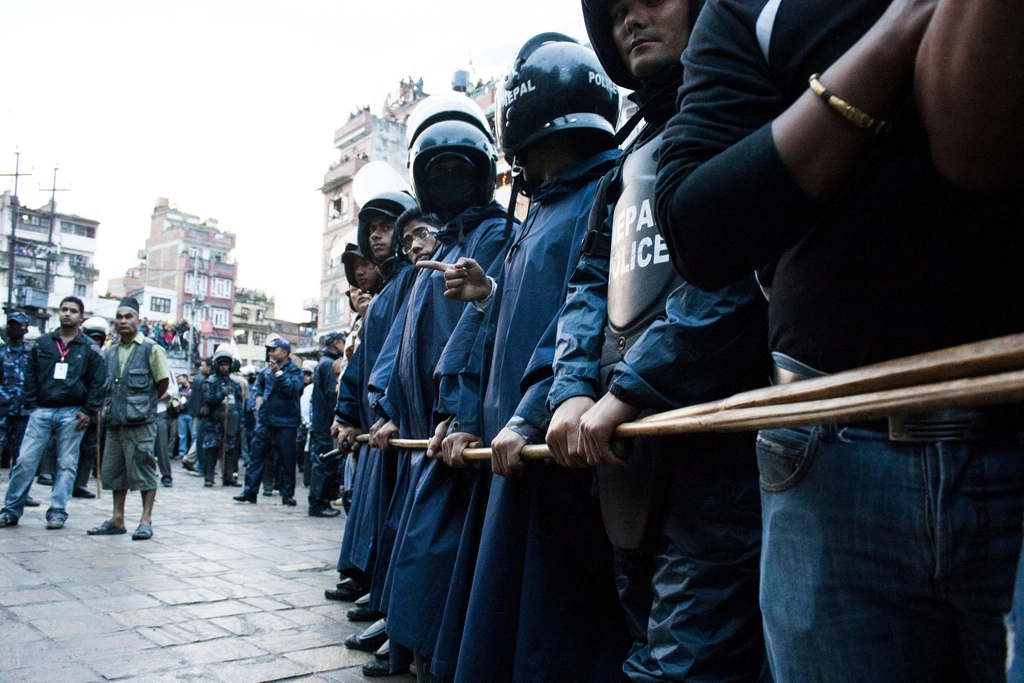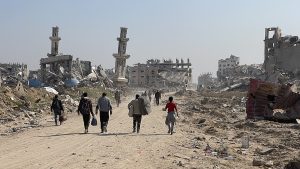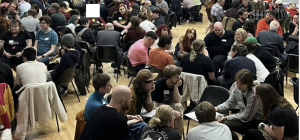
Nepal protests have deeper roots
Alex de Jong •Under the right conditions, a spark can start a prairie fire. Protests against a social media in Nepal ban grew into a full blown uprising after police killed 19 protesters. Houses of prominent politicians were attacked, the parliament set on fire and the government is in shambles. Alex de Jong asks what’s next?
This article was first published on the International Viewpoint website on 12 September 2025.
In an article for Himal Southasian, Roman Gautam pointed out the influence of other uprisings; ‘when Sri Lankans rose up in 2022 to boot out the Rajapaksa regime’, Nepalis ‘took notice. Then came Bangladesh and its July Revolution last year, with Sheikh Hasina and the entire political system around her in the public’s sights’. And in footage of protests in Nepal, the same skull and bones flag that became a symbol of Indonesian protests can be seen.
The initial trigger was a ban on social media, something many people who run small businesses rely on. Social media such as WhatsApp and Messenger is also line of communication with the millions of Nepali migrant workers abroad. About 7.5 per cent of Nepal’s population lives abroad and remittances account for over a quarter of the country’s GDP, more than official development assistance and foreign direct investment combined. The large scale migration is driven by poor prospects at home, where almost one in four young people is unemployed. Viral recordings of the children of politicians enjoying lavish lifestyles added fuel to the fire.
Under such conditions, protest against a social media ban quickly widened into one a movement against the corrupt and unaccountable politicians held to be responsible for a lack of prospects. And then on 8 September, police opened fire, killing 19. Among the dead were children still in their school uniform. This kind of violence was carried out by a government led by a self-declared communist, KP Sharma Oli of the Communist Party of Nepal (Unified Marxist–Leninist) or CPN UML. Anger escalated into outrage. A day later, Oli stepped down and the social media ban was lifted but this was too little too late.
The discrediting of the Oli-led coalition of CPN UML and the Nepali Congress is not limited to those two parties. Tellingly, on Tuesday the house of opposition politician and former prime-minster Prachanda was also attacked. Like Oli, Prachanda is a self-declared Communist; he is the chairman of the Communist Party of Nepal (Maoist Centre). CPN UML, Nepali Congress and Maoist Centre are the three major political parties in the country. Since 2008, Nepal has had 13 governments, with these three parties cycling in and out of power.
Decline and collapse of a revolution
This is not the first time in recent history that Nepal has seen a mass uprising. In 1990, popular protests ended monarchical rule in Nepal and the country became a multi-party constitutional monarchy. The CPN UML, which began as a left front participating in this movement, then estlibshed itself as one of the country’s major political parties.
Despite its name, there is little communist about this party’s ideology. In the early nineties, its Secretary General Madan Bhandari formulated the party’s approach, the ‘theory of people’s multiparty democracy’. This was essentially a continuation of the party’s previous Stalinist stagist theory of revolution. It maintained the old conception that before any kind of socialism would be possible, there needed to be a phase in which, in alliance with so-called ‘national capitalists’, capital accumulation would be developed. Bhandari’s formulation added that this ‘New democratic’ phase would be achieved through electoral means, via parliament, and respect political pluralism. In what became the CPN UML’s foundational documents Bhandari, who died in 1994, stressed that New Democracy is ‘not different in socio-economic structure and production system’. It would be a ‘basically capitalist production system’, to be achieved by the ‘working people and common people’.
Much of Nepali politics in the nineties were characterised by competition between the CPN UML, NC, a nominally social-democratic party, and the Hindu-nationalist, monarchist Rastriya Prajatantra Party. Much of the criticism the parties directed at each other revolved around accusations of corruption and nepotism, rather than political ideology. One difference was in international orientation: NC was historically seen as pro-India while the CPN-UML ‘admires the great achievements of building socialism with Chinese characteristics’ by the Chinese Communist Party. Despite such differences, all three of these parties at different times formed (government) coalitions in the years between 1990 and 2005 when the king assumed executive power.
Part of the tragedy of Nepal is that Prachanda’s Maoist movement arose as revolutionary movement that promised an end to social and economic stagnation and to break the dominance of the established parties. In 1996 the Maoists presented the government, at that point led by the NC, with a 40-point list of demands that included land distribution, a system of unemployment benefits, health care and education as well as an end to caste-based discrimination and autonomy for marginalised regions. When their demands were not met, they launched an armed struggle against the Nepali state.The Maoist ‘people’s war’ gathered strength around the turn of the century when the Maoists controlled large parts of the countryside. As the insurgency grew, Nepali king Gyanendra, who was also the commander of the army, concentrated power in his own hands.
But by doing so, the king antagonised most of the political parties, including the Nepali Congress and CPN UML. In April 2006, a mass movement broke out in Nepal’s cities. Named Jana Andolan II or People’s Movement II after the 1990 movement, the protests led to the stripping of all powers from the king and reinstatement of parliamentary rule. The Maoists in the meantime had come to an agreement with the opposition parties and committed themselves to a negotiated end of the armed struggle. Their goal now was ‘multiparty competition within a stipulated constitutional framework’, as Prachanda put it. On 21 November 2006, the Maoists announced the end of their insurgency and the dissolving of the political organs it led in the country side. The Maoists then joined the interim government.
During the people’s war, the Maoists emphasised that their immediate goal was to ‘build a new type of national capitalist relations, oriented towards socialism’. When speaking in 2001 with a reporter from The Washington Times Baburam Bhattarai, their main ideologue at the time, implored him to ‘please note that we are not pressing for a ‘communist republic’ but for a bourgeois democratic republic.’ This strategy was similar to that of CPN UML but differed on how to achieve the preparatory phase of ‘national capitalism’, either through elections or armed struggle.
In 2001, Bhattarai also declared there was ‘absolutely no possibility’ of the Maoists turning into a ‘parliamentary party’ and thereby ‘betray the revolutionary aspirations of the masses’. But this is exactly what happened after 2006. As successful as they had been on the battlefield, in the institutional arena the Maoists were first outmaneuvered by the established parties and then quickly assimilated.
The progressive character of the draft constitution was steadily whittled down. It did not take long for the Maoist leadership to fall apart and start accusing each-other of corruption. Even money that was meant to go to the former fighters who were to be integrated into the national army went missing. The change in lifestyle of someone like Prachanda was indeed conspicuous. Some radical groups left the party, but those offered little more than a repeat of the old dogmas and a promise of something few people want; a return to the people’s war at some future point.
Musical chairs
Once the new constitution was introduced, it did contain some progressive changes, such as the country becoming a secular republic. But other democratic provisions, such as more political power for marginalised regions in a federal system, were not or only partially implemented. For many working Nepalis little changed in their daily lives.
Since 2008, Maoists were prime-minsters of Nepal four times: Bhattarai once, Prachanda three times, most recently from 2022 to 2024. At different times, the Maoists formed coalitions with each of the main parties of the recently collapsed government. In 2018, the CPN UML and the Maoists, parties that not long before had been at each-other’s throat, even went through a short-lived fusion. The failure of this fusion, like other splits from the CPN UML and the Maoists in 2021, was largely caused by disagreements over positions. A cynic might say that almost 20.000 people died in the people’s war so that the Maoists could join the political game of musical chairs.
With many of the country’s fundamental problems unresolved, it is no surprise that right-wing forces are making a comeback. Earlier this year, Nepal saw substantial protests of monarchists. Restoring the kingdom is a minority position but the monarchists are energised by the obvious failure of CPN UML, NC and Maoist Centre. The ‘resurgence of pro-monarchy activities’, as one Nepali journalist put it, ‘is reflective more of the old guard trying to cash in on widespread public frustration rather than a show of support for the discredited institution’. There are rumours that right-wing, monarchist forces have also been stoking the recent violence. Likewise, fingers are pointed at India and Hindu nationalist forces that would like to see Nepal’s status as a Hindu state restored and Nepal’s foreign orientation shifted away from China to India. That such forces are attempting to benefit from the current situation is quite possible. Obviously these kind of manoeuvres were made possible in the first place by wide-spread anger and disappointment.
The legitimate anger over corruption can be a step towards social radicalism. But there is also a risk of such energy being captured by more conservative forces, as the fate of other anti-corruption protests shows. Especially among urban middle-classes and NGO- activists, neoliberal notions of ‘good governance’ locate the root of poverty and underdevelopment not in imperialism and capitalist exploitation but in the failure to ‘uphold the rule of law’. The feeling that ‘they are all corrupt’ can fuel the desire for a strong man, for an outsider who will ‘drain the swamp’.
Protest movements can bring down a government but taking power to actually change the course of society is another thing. Anti-corruption agencies are not enough when what is at stake are matters like land reform, minority self-determination, workers rights and fighting the rule of capital. The cases of Sri Lanka, where popular revolt led to a government that is essentially continuing neoliberal policies, and Bangladesh, where after the July 2024 uprising, it is the right-wing that is set to grow are sobering examples. But it would be a grave mistake to draw from this the lesson that the left should abstain from such protests, or even worse support governments whose blatant corruption and incompetence has led them to lose popular support. History is made when the masses enter into action. Socialists need to be part of such struggles in order to be able to point to a better way.







0 comments